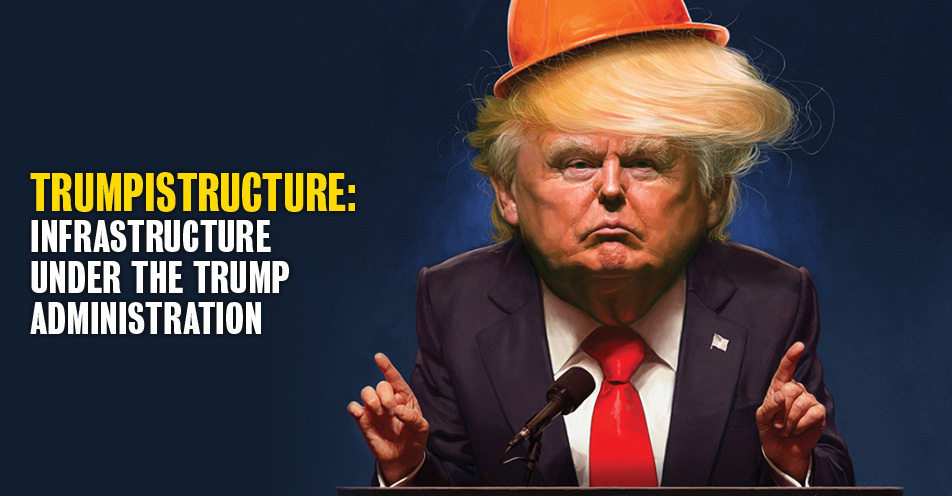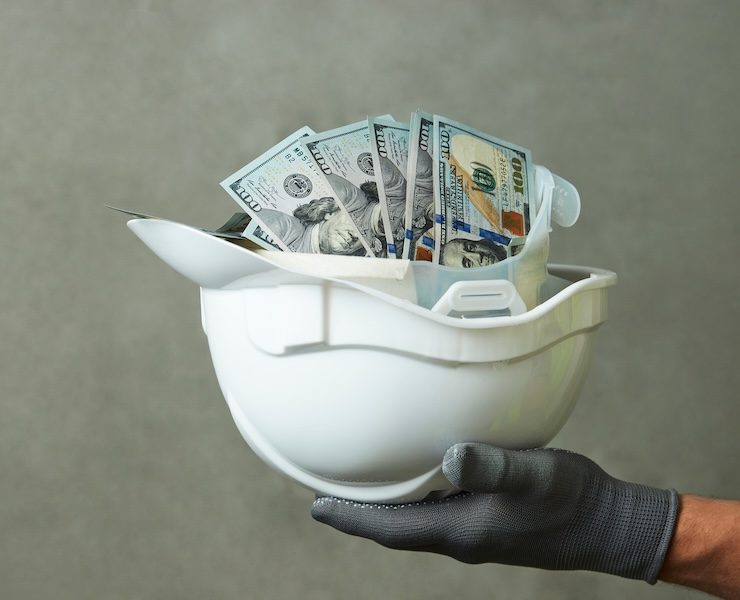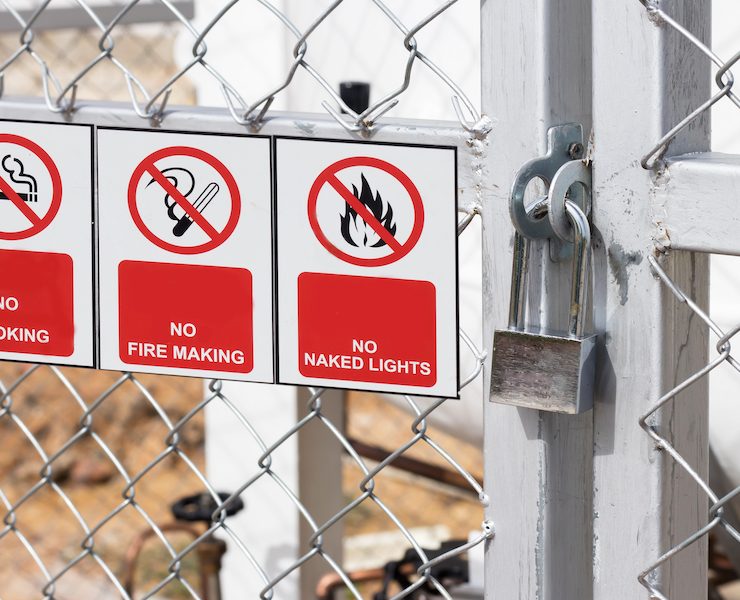Trumpistructure: The Trump Administration and Rebuilding U.S. Infrastructure

By Mark Rice, Esq.
The last eight plus years of divided government and gridlock in Washington has meant, literally, gridlock.
Gridlock of cars on our roads, highways, bridges, airport reconstruction, and a bevy of other overdue public works. Not good. Not good for the tires on my car, and worse for American families, jobs, and good old-fashion American roll-up-the-shirt-sleeves buzz of activity.
President-elect Trump has promised investment in infrastructure.
“We are going to fix our inner cities and rebuild our highways, bridges, tunnels, airports, schools, hospitals,” Trump said. “We’re going to rebuild our infrastructure, which will become, by the way, second to none. And we will put millions of our people to work as we rebuild it.”
We now have one party, so to speak, running Congress and the White House. Therefore, there is no reason to “say, no” anymore to roads, jobs bills and traditional, transportation and infrastructure appropriations.
Historically, along with American ingenuity and entrepreneurship, large infrastructure projects have made the economy tick. Contractors know this more than anyone.
In 1785, George Washington, a surveyor by trade, created the Potomac Company to build five skirting canals past waterfalls to commercially connect the Potomac and Ohio Rivers from the Great Lakes to the Atlantic to give America’s inland goods access to world markets. If George could do it, then so can we.
Starting right now, the heavy construction industry is unusually poised to speak with one voice and help government re-learn from over-regulation and dried-up financing and funding, to get money back into the ground where it converts to economic growth, efficiency, and well- paying, secure jobs.
It used to be the case that no matter the party in power, and no matter the state of the economy, keeping the highly-qualified, high-end heavy construction workforce busy with big, public projects was common bread, fully-supported by industry leaders, collective bargaining teams, politicians, and pork on the barrel.
Then, the 2008 the great recession hit. By then, emerging “identity politics” and scorched- earth media in all directions had replaced the get-along model exemplified by scenes of Ronald Reagan and Tip O’Neil singing songs together to cajole lesser souls to compromise and bring home bread for constituents.
Instead, gas taxes collected and earmarked for transportation works were shifted to other unmet needs such as schools and entitlements, themselves both bloated and flailing.
Once again, not good.
Decaying roads, highways, bridges, airports, major waterworks, and other infrastructure were left to sit on the sidelines while new politics sifted itself out.
It seemed so long ago, the era of the great highway systems built under President Eisenhower, or the dynamic public works such as the Hoover Dam and Tennessee Valley Authority (TVA) under the New Deal that inspired the nation out of the Great Depression.
The country was, and is, in need of new iterations and new inspirations, that go beyond the creative genius of I-phones and Pixar, cultural salve and 24-hour news.
The nation yearns for grit again and engineering feats.
It sorely looks to today’s new Joseph Strauss’s[1] and public-private partnerships to convince the nation’s finance and bond markets to back reinvestment.
The new and iconic replacement of the eastern approach of the San Francisco-Oakland Bay Bridge fit that bill, though much of the work was outsourced and prefabbed in China, where questions about the seismic bolts still persist.
President-elect Trump is, to be sure, from a family with a history of building projects. He knows how to build. That know-how will come in handy.
The approach one hopes is to leverage private dollars, tax incentives for infrastructure investment, and private-public partnerships, as well as traditional Federal funding for qualified local and state infrastructure projects.
There is not going to be one-size-fits-all. Hopefully though, “yes” votes on transportation appropriations and tax incentive bills in Congress will aim at restoring not just infrastructure. Legislation can bullseye squarely at the message of the election — the deep commitment in America to infrastructure building, as what we do. As who we are. And as what made us great and makes us great.
So the specifics — the devilish details.
Here has been our national report card on infrastructure investment of late. Every four years, the American Society of Civil Engineers (ASCE)’s issues a national, industry-by-industry, state-by-state report card on infrastructure.
The last report was in 2013. The grade was a D+ overall — failing — with an unmet infrastructure replacement and refurbishing need of $3.6 trillion:
The 2013 Report Card grades show we have a significant backlog of overdue maintenance across our infrastructure systems, a pressing need for modernization, and an immense opportunity to create reliable, long-term funding, but they also show that we can improve the current condition of our nation’s infrastructure — when investments are made and projects move forward, the grades rise.
The only B grade that year was in solid waste management. ASCE said it well in the report’s comments:
We know that investing in infrastructure is essential to support healthy, vibrant communities. Infrastructure is also critical for long-term economic growth, increasing GDP, employment, household income, and exports. The reverse is also true – without prioritizing our nation’s infrastructure needs, deteriorating conditions can become a drag on the economy.
While our politics have split along rural and urban lines, when it comes to infrastructure, the grade has been bad everywhere.
In 2013, California, New York, Texas and North Carolina all pulled in C’s.
Michigan, a D. New Jersey and Arkansas, each a D+.
According to the World Economic Forum, the U.S. infrastructure now ranks 12th in the world, after Singapore and the United Arab Emirates. That hurts.
Another four years has passed since that report card. There has been no significant rebuilding or rebooting of America infrastructure.
As the website for the U.S. Chamber of Commerce points out, while we seem to agree that rebuilding U.S. infrastructure is key to economic growth, jobs and competitiveness, we have real trouble agreeing on how to pay for it.
If this last election sent any core message, it was once again, “it’s the economy, stupid.”
Rural America has not received the bounty that the coasts have from globalization, and the ballot box was a scathing and sobering report card on those misaligned interests.
Those hurt the most showed up to vote. Aside from relentless political punditry, the message was, and now should be, about fixing decaying roads, bridges, hospitals, airports, and other important barn-raising projects that invariably make an economy hum.
We are on the cusp of 2017. Trumpistructure is around the corner. Posted on Trump’s campaign website is a ten page white paper[2] on what this may look like.
Highlights:
- There is bipartisan support in Congress for a massive infrastructure bill. Its shape — that is where politics hopefully can be set aside ever so briefly for the good of the nation.
- The Wall Street Journal reported that construction industry stocks soared on hearing of the Trump electoral victory — even if the details were unclear.
- President-elect Trump has pledged a $1 Trillion infrastructure plan over the next ten years — albeit, that is but 30% of ASCE’s 2013 unmet investment need amount of $3.6 Trillion.
- Cutting regulations both at state and federal levels that bog down the flow of funds to local agencies issuing bid solicitations, is at the heart of getting dollars to donuts. These include endless studies, and then endless lawsuits over the endless studies.
- There are tax incentives in $139 billion of Federal tax credits to those investing in transportation projects, intended to leverage Federal monies.
- Among the benchmarks of the Trump private-over-public approach in the white paper is a new emphasis on private money that will be different than traditional, government funding models: “The Trump infrastructure plan features a major private sector, revenue neutral option to help finance a significant share of the nation’s infrastructure needs…This innovative financing option would serve as a critical supplement to existing financing programs, public-private partnerships, build America bonds, and other prudent funding opportunities.”
By revenue neutral, Trumpistructure means not financed by deficient spending — e.g., a non-Keynesian plan[3]. While Public Private Partnerships (P3) have had success, it is usually around a long term ground lease model, such as toll roads, where the private partners secure long term paybacks with fair rates of built-in investment return. Naturally, facing such a plan, there are critics and skeptics on both sides of the aisle. Fiscal conservatives think that the plan will not be revenue neutral and will increase the national debt.
On the other side of the aisle, expect that the more Keynesian, Blue State, tax-and-spend types see the revenue neutral as unlikely, or a wink-and-a-nod, to the right’s disdain for government spending projects as solutions.
In contrast, too little spending is an incentive to investors to back American infrastructure in earnest over other options such as investing in China, gold or high tech.
As we cannot forget, in an internet age of instant wire transfers, global dollars fly fast by automatized investment logarithms and are not very nationalistic.
Global dollars flow where the returns are seen as highest and have no borders. Adam Smith’s Invisible Hand theory[4] reminds us that supply-and-demand means, if a large investor can make more money on global futures instead of American tax breaks for roads, the futures it is.
It has been reported that the Trump transition team is starting to talk about a private infrastructure bank — Bravo. The idea of an national infrastructure reinvestment bank to leverage Federal dollars and private investment for projects in energy, transportation and other public works has been around since at least 2007, though the model of the bills that have expired in three Congresses so far have been modeled after the FDIC, and with powers to issue investor bonds and borrow from world credit markets to issue loans to build.
One suspects that everything will be on the table as the finance and funding models are kicked around. Martin Marietta CEO Howard Nye spelled it out in an interview on CNBC[5] — any plan will need to be a blend of both private financing and public funding.
Sounds like a fight in Congress unless cooler heads prevail — meaning construction industry stakeholders who know how to build, and need Congress and financial markets to get banking, bond markets and governmental bureaucracies and budgets to harmonize, if only briefly, so ground breaking projects can take shape.
Then, there is also project mix — how much for roads, for flood control against repeats of Katrina, for replacing old 60” water pipelines, for growth sectors such as clean and renewable energy, the impact of the internet-of-things, and even public or lower cost housing to curb the decreasing home ownership rates. A lot of hands out with tin cups.
As is the case with all policy pronouncements, detractors and blogs follow quickly.
Some call it a privatization scam, others in Congress suggest a wait-and-see approach while hot topics such as more health care reforms take center stage.
Some Trump advisors have suggested a one time, 10 percent tax on overseas U.S. corporate profits (e.g., Apple domiciled in Ireland), but, that too, has push back. The knives are being sharpened for this possibly epic and critical battle.
What is Trump's infrastructure plan and how does it aim to address the nation's infrastructure challenges?
Trump's infrastructure plan pledges a $1 trillion investment over the next decade, focusing on bipartisan support in Congress, cutting regulations, tax incentives, and leveraging private-sector financing.
How does Trumpistructure differ from traditional infrastructure funding models, and what challenges does it face in terms of bipartisan support?
Trumpistructure emphasizes private-sector involvement, revenue-neutral financing options, and tax incentives, facing scrutiny from both fiscal conservatives and proponents of traditional government spending.

















